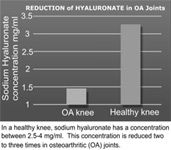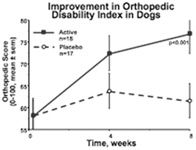A non-drug approach to pain: Fringe therapies for fringe benefits? (Proceedings)
Clients tend to come into our exam rooms with many different ideas on how to treat their pet's arthritis, both the pain and as a disease.
Clients tend to come into our exam rooms with many different ideas on how to treat their pet's arthritis, both the pain and as a disease. Virtually all of the products are not drugs, and therefore have not undergone the scrutiny of the FDA approval process. Additionally, most products have undergone very little to no research. As a result, there is likely no scientific basis for their use. We know that any product can induce a placebo effect and that any company can choose to just report good testimonials and anecdotal information. A number of products have apparent efficacy and varying degrees of research to support their use. These include glucosamine/chondroitin products, oral hyaluronic acid formulations, Microlactin and elk antler velvet.
Glucosamine-containing supplements
There is ongoing controversy surrounding glucosamine –containing products for the treatment of osteoarthritis. The first important concept with these products is to recognize that not all products are created equally. A study from the University of Maryland in 2000 indicated that 80% of glucosamine containing products do not contain the amounts of glucosamine as indicated on the label. One way to help assure quality of ingredients is to find products which follow US Pharmacopaeia (USP) standards. The next important aspect is to recognize that not all glucosamine formulations have the same in vivo effects. For example, glucosamine sulfate is not nearly as efficacious as glucosamine HCl. After getting past the glucosamine, it is important to look at the other ingredients in the formulation.
Like glucosamine, chondroitin sulfate efficacy can vary depending on its particular formulation. Most products have high molecular weight chondroitin, which is absorbed very little from the GI tract of humans, dogs, and horses. Low molecular weight chondroitin, a small molecule, is a proprietary formulation found in Cosequin and Dasuquin and has associated data showing its absorption from the GI tract.
While glucosamine HCl and low molecular weight chondroitin have been documented to have significant bioactivity in cartilage, their combination with manganese, has a greater effect. Manganese has a catalyst effect, increasing bioactivity a significant amount.
Perna canaliculus, green lipped muscle, can be found in some products such as Glycoflex III. While the data is old, it has been shown to be effective at pain relief, at least in the laboratory setting.
There are a number of published papers which has shown that Cosequin (glucosamine HCl, low molecular weight chondroitin, and manganese) has many beneficial effects on cartilage in dogs and other species. This combination has also been shown to be a preventative effect. Patients receiving Cosequin prior to an acute joint injury heal more quickly than those who start to receive it afterwards.
Glycoflex III has Perna canaliculus, glucosamine HCl, manganese, methylsulfonylmethane (MSM), DMG, vitamins E&C, grape seed extract, glutathione, and selenium. Only the first three components have known efficacy associated with them. However, there is emerging data that Glycoflex III may reduce the severity of cartilage breakdown and synovitis and appears to have an anti-inflammatory effect. Data is still pending on its effect in clinically affected patients.
When evaluating data for any glucosamine containing product, be sure the material being presented by a company representative actually pertains to the particular product and not that of another manufacturer. This can happen quite frequently. Beware!
Hyaluronic acid
Hyaluronic acid, (HA) exists naturally in all living organisms. It is found in greatest concentrations in the synovial fluid of joints for lubrication, the vitreous humor (fluid) of the eye, and in the skin. Hyaluronic acid plays an important role in tissue hydration, lubrication and cellular function, and is able to hold more water than any other natural substance. Hyaluronic acid (HA) is a special mucopolysacharide. Its concentration decreases with osteoarthritis. (Figure 1). When present in a joint, even a joint with minimal or no cartilage, it can provide a cushion effect. High molecular weight HA has been shown to provide better joint lubrication than low molecular weight HA.

Figure 1. Graphical representation of the quantity of hyaluronic acid in normal knees and those with osteoarthritis.
Injectable hyaluronic acid is available as an FDA approved drug for use in horses (Legend).There are no FDA approved oral versions of HA. However, there is good evidence that high molecular weight HA is absorbed through the GI tract and provides good knee lubrication in humans. There are no comparable animal studies, but clinical impressions of many veterinarians are that oral HA can act as a good adjunct to increasing pain control in dogs and cats with osteoarthritis.
Microlactin
Duralactin contains MicroLactin, a patented special dried milk protein from the milk of hyperimmunized cows. Partially purified preparations inhibit inflammation in many laboratory animal models. The anti-inflammatory activity is bio-available both orally and systemically, is effective regardless of the etiology of the inflammation, and appears to function with no evidence of gastro-intestinal tract irritation.Unlike steroids and non-steroidal anti-inflammatory drugs (NSAIDs), Duralactin has no demonstrable cyclo-oxygenase (COX) inhibiting activity or short or long term toxic effects in any species studied thus far. This is especially important for dogs in which long-term management of musculoskeletal disorders is indicated and the extended use of steroids or NSAIDs is contraindicated.
In a recent placebo-controlled study in dogs showing signs of osteoarthritis, Duralactin induced a significant improvement in standardized and patient-specific questionnaire scores and in owner global assessments (Figure 2).

Figure 2. Duralactin (active) induced improvement in dogs versus placebo
Elk antler velvet
Elk antler velvet is harvested from the male elk during the velvet stage of growth, when the antler contains the most nutritional value. The inner cartilaginous matrix, not the outside velvet covering is used as the supplement. The bioactive components of the antler velvet include type II collagen, glycosaminoglycans (chondroitin sulfate), polysaccharides, growth hormone, and various prostaglandins.
Elk antler velvet has been shown to aid in the performance of human athletes and may help with osteoporosis in women. In a double-blinded, placebo-controlled study, CanEVA – K9 (Canadian Elk Velvet Antler of Dogs) was effective in alleviating the clinical signs of arthritis in dogs and improved ground reaction forces. Additionally, investigators observed that the dogs receiving CanEVA had a significant reduction of muscle atrophy, suggesting a myotrophic effect.
Conclusion
As clients seek out therapies for their pets with arthritis pain, it is important for us, as practitioners, to guide them to products which are based on sound scientific principles and have efficacy associated with them. Most approved medication work well to variable degrees in their target species. The non-FDA approved substances may be more problematic. Guide your clients to products you can trust based on science, not sales reps.
Podcast CE: A Surgeon’s Perspective on Current Trends for the Management of Osteoarthritis, Part 1
May 17th 2024David L. Dycus, DVM, MS, CCRP, DACVS joins Adam Christman, DVM, MBA, to discuss a proactive approach to the diagnosis of osteoarthritis and the best tools for general practice.
Listen









